
In recent years, the integration of artificial intelligence (AI) in various industries has revolutionized processes and improved efficiency. One such field benefiting from AI is agriculture. With the growing demand for sustainable and efficient food systems, AI presents opportunities to optimize crop production, enhance livestock management, and optimize resource allocation. In this article, we will explore the role of artificial intelligence in agriculture and its impact on cultivating sustainable and efficient food systems.
2. The Role of Artificial Intelligence in Agriculture
Artificial intelligence is revolutionizing the agricultural sector by providing advanced technological solutions to address the challenges faced by farmers. By leveraging machine learning algorithms and data analytics, AI systems can process vast amounts of agricultural data, enabling farmers to make informed decisions and optimize their operations.
3. Enhancing Crop Production
3.1 Automated Irrigation Systems
AI-powered automated irrigation systems are transforming traditional irrigation methods. These systems utilize sensors to monitor soil moisture levels and weather conditions in real-time. By analyzing this data, the systems can precisely determine the irrigation needs of crops, preventing both over and under-watering. This technology optimizes water usage, minimizes resource waste, and promotes sustainable farming practices.
3.2 Precision Farming
Precision farming involves using AI and GPS technology to apply precise amounts of fertilizers, pesticides, and water to specific areas of a field. By collecting and analyzing data on soil composition, crop health, and weather patterns, farmers can tailor their interventions to meet the precise needs of different areas within their fields. This targeted approach minimizes the use of agrochemicals, reduces costs, and increases overall crop yields.
3.3 Crop Monitoring and Disease Detection
AI-based technologies enable farmers to monitor crop growth and health using remote sensing, satellite imagery, and drones. By capturing high-resolution images and employing machine learning algorithms, these systems can detect early signs of crop diseases, nutrient deficiencies, and pest infestations. Timely detection allows farmers to take preventive measures, reducing crop losses and ensuring sustainable production.
4. Improving Livestock Management
4.1 Automated Feeding Systems
AI-powered automated feeding systems streamline the feeding process for livestock. These systems use sensors and data analysis to provide animals with optimal nutrition based on their individual needs. By monitoring feed consumption, weight gain, and health indicators, farmers can ensure that their livestock receives the right nutrients at the right time, maximizing their growth and overall well-being.
4.2 Health Monitoring
AI systems play a vital role in monitoring the health of livestock. Wearable devices equipped with sensors can track vital parameters such as heart rate, body temperature, and activity levels. By analyzing this data, farmers can detect early signs of illness or distress in their animals. Early intervention can prevent the spread of diseases, minimize animal suffering, and improve overall productivity in livestock farming.
5. Optimizing Resource Management
5.1 Water Conservation
Water scarcity is a significant concern in agriculture. AI technology helps farmers optimize water usage through intelligent irrigation systems and water management strategies. By analyzing data on soil moisture, weather patterns, and crop water requirements, AI systems can automate irrigation schedules, ensuring that crops receive adequate water without excessive wastage. This approach promotes water conservation, reduces costs, and mitigates the impact of water scarcity on agricultural production.
5.2 Fertilizer and Pesticide Optimization
Traditional farming practices often involve excessive use of fertilizers and pesticides, leading to environmental pollution and health risks. AI offers solutions for optimizing the application of these agrochemicals. By analyzing soil composition, crop data, and pest presence, AI systems can recommend precise quantities and timings for fertilizer and pesticide application. This targeted approach minimizes environmental impact, preserves soil health, and improves the sustainability of farming operations.
6. Sustainable Farming Practices
6.1 Soil Health Management
Maintaining healthy soil is crucial for sustainable agriculture. AI technology assists in soil health management by analyzing soil composition, moisture levels, and nutrient content. Based on this analysis, AI systems can provide recommendations for soil amendments, crop rotation strategies, and cover cropping techniques. These practices promote soil fertility, prevent soil erosion, and contribute to long-term sustainable farming.
6.2 Climate Prediction
Climate change poses significant challenges to agricultural productivity. AI-based climate prediction models leverage historical climate data, satellite imagery, and machine learning algorithms to forecast weather patterns with greater accuracy. This information helps farmers make informed decisions regarding planting schedules, crop selection, and pest management. By adapting farming practices to changing climate conditions, farmers can mitigate risks, optimize yields, and foster sustainable agricultural systems.
6.3 Biodiversity Conservation
Maintaining biodiversity on farms is crucial for sustainable food production and ecosystem balance. AI technology aids in biodiversity conservation by monitoring and analyzing data on plant and animal populations, ecological interactions, and habitat quality. By identifying endangered species, promoting habitat restoration, and implementing conservation strategies, AI systems contribute to the preservation of biodiversity and the resilience of agricultural ecosystems.
7. Overcoming Challenges
7.1 Data Security and Privacy
The integration of AI in agriculture involves the collection and analysis of large amounts of data. Ensuring data security and privacy is essential to protect farmers' sensitive information and maintain public trust. Agricultural organizations and technology providers must implement robust data protection measures, including encryption, access controls, and secure data storage, to safeguard farmer data and maintain the integrity of AI systems.
7.2 Adoption and Affordability
The adoption of AI technology in agriculture can be hindered by factors such as cost, technological literacy, and infrastructure limitations. To overcome these challenges, governments, agricultural organizations, and technology providers need to collaborate in promoting awareness, providing training and support, and offering affordable access to AI solutions. Initiatives that foster knowledge exchange, incentivize adoption, and reduce barriers can accelerate the integration of AI into agriculture and benefit farmers globally.
8. Future Prospects
The future of AI in agriculture holds immense potential. Continued advancements in machine learning, robotics, and sensor technology will enable further innovation and automation in farming processes. AI systems will become more sophisticated, capable of analyzing vast amounts of data in real-time, and providing predictive insights for proactive decision-making. The integration of AI with other emerging technologies, such as blockchain and the Internet of Things (IoT), will enhance traceability, transparency, and efficiency across the agricultural value chain.
9. Conclusion
Artificial intelligence is revolutionizing agriculture by providing farmers with innovative tools and insights to cultivate sustainable and efficient food systems. Through enhanced crop production, improved livestock management, optimized resource allocation, and the promotion of sustainable farming practices, AI is transforming the agricultural landscape. By leveraging AI technology, farmers can optimize water usage, reduce agrochemical usage, monitor crop health, and make data-driven decisions for better productivity and environmental stewardship. However, challenges such as data security, privacy, and adoption need to be addressed for widespread implementation.
In conclusion, artificial intelligence in agriculture is empowering farmers to cultivate sustainable and efficient food systems. With its ability to analyze data, provide predictive insights, and automate various farming processes, AI is revolutionizing the way we produce food. By embracing AI technologies and practices, we can enhance food production, minimize environmental impact, and ensure a more sustainable future for agriculture.
10. FAQs (Frequently Asked Questions)
Q: How does artificial intelligence help farmers increase crop yields?
A: Artificial intelligence enables farmers to optimize irrigation, apply precise amounts of fertilizers and pesticides, and monitor crop health, leading to increased crop yields.
Q: Can AI help in reducing water consumption in agriculture?
A: Yes, AI-powered irrigation systems can analyze soil moisture levels, weather conditions, and crop water requirements to optimize water usage, conserving this valuable resource.
Q: Are there any privacy concerns regarding the use of AI in agriculture?
A: Data security and privacy are crucial considerations when implementing AI in agriculture. Robust measures, such as encryption and access controls, must be in place to protect farmer data.
Q: How can AI contribute to biodiversity conservation in agriculture?
A: AI technology can monitor and analyze data on plant and animal populations, ecological interactions, and habitat quality, aiding in the identification and implementation of biodiversity conservation strategies.
Q: What are the challenges in adopting AI technology in agriculture?
A: Challenges include affordability, technological literacy, and infrastructure limitations. Collaborative efforts are needed to address these challenges and promote widespread adoption of AI in agriculture.
About the Creator
Aditi
I Love to Write, I hope you love to read






Comments
There are no comments for this story
Be the first to respond and start the conversation.